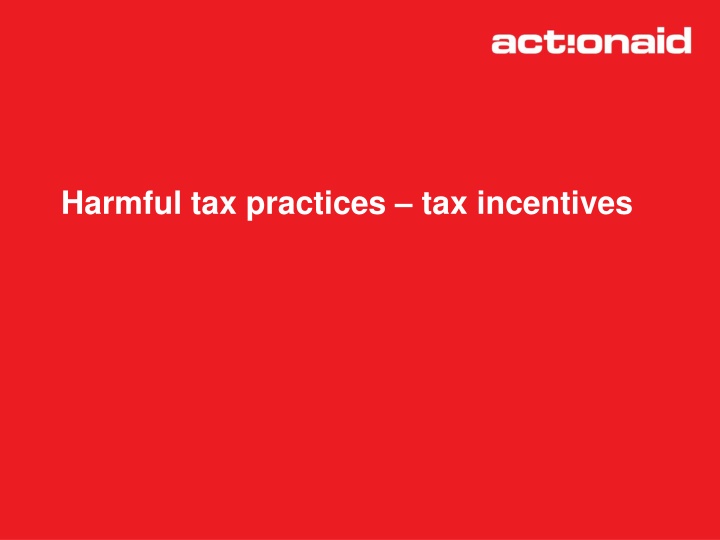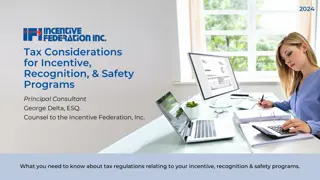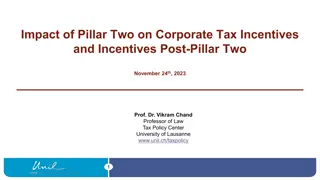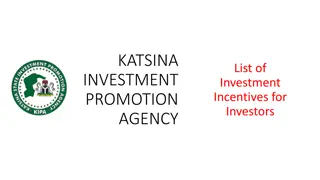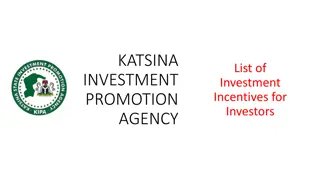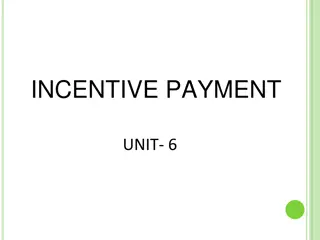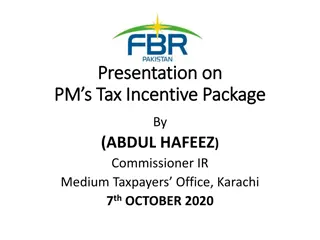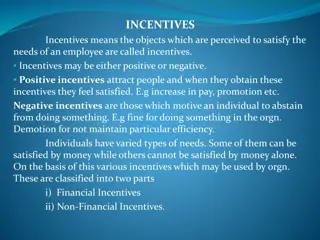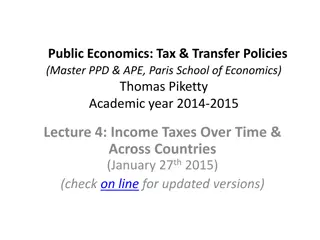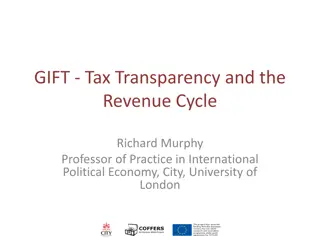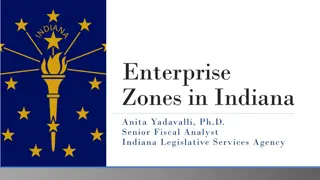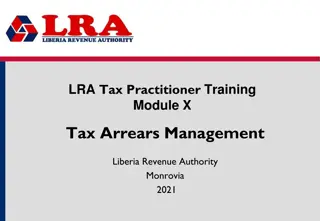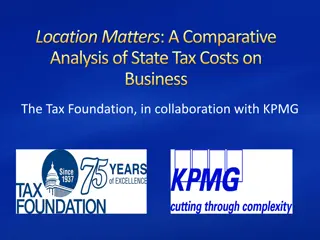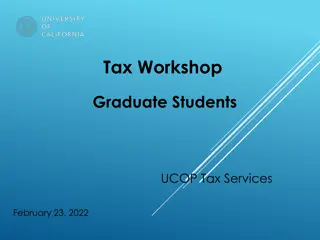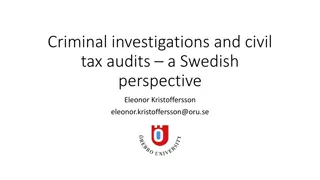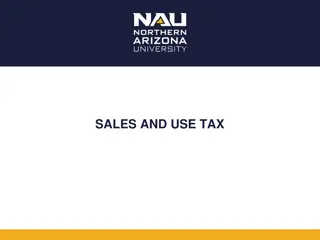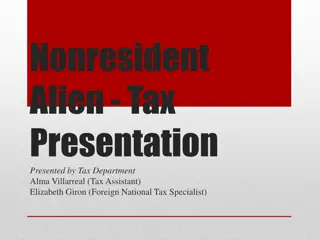Harmful Tax Practices and Incentives
Impact of harmful tax practices and incentives on the economy. Learn about the potential risks associated with these practices and how they can be mitigated. Understand the complexities of tax systems and the importance of fair and transparent tax policies.
Download Presentation

Please find below an Image/Link to download the presentation.
The content on the website is provided AS IS for your information and personal use only. It may not be sold, licensed, or shared on other websites without obtaining consent from the author.If you encounter any issues during the download, it is possible that the publisher has removed the file from their server.
You are allowed to download the files provided on this website for personal or commercial use, subject to the condition that they are used lawfully. All files are the property of their respective owners.
The content on the website is provided AS IS for your information and personal use only. It may not be sold, licensed, or shared on other websites without obtaining consent from the author.
E N D
Presentation Transcript
Introduction to the available resources - http://www.christianaid.org.uk/ActNow/trace-the- tax/resources/index.aspx?Page=3 - http://www.taxjustice.net/cms/front_content.php?idcat=1 04 - http://martinhearson.wordpress.com/
Overview of the tax system - Indirect and direct taxation - Trade taxes - Rents - Residence vs. source taxation (cross-border) Is the tax system progressive or regressive?
Tax losses - Evasion/fraud - Avoidance/tax planning - Incentives - Individuals and corporates
What issue could a campaign against tax dodging in my country focus on? Who would the target be? What are the strengths, weaknesses, opportunities, threats associated with campaigning on that issue/target? What would the campaign look and feel like and how would it deal with the power dynamics behind tax dodging?
Tax incentives What tax incentives are commonly offered by governments? What might distinguish a good incentive from a bad incentive? How might incentives be used in tax avoidance?
Extrapolating from the share of GDP lost through statutory corporate income tax (CIT) exemptions in 16 developing countries in various years, we estimate that developing countries lost USD 138.9 bn to statutory corporate income tax exemptions in 2011.
Tax incentives in business decisions? - 2011 G20 report (by IMF, OECD, UN, WB): incentives undermine CIT revenue, do little to attract investment where governance is poor, or where they attract investment, it is footloose - WB EAC Investor Motivation Survey: 93% of investors would have invested without tax incentives; tax incentives ranked 17thin factors deciding location of investment - 2009 IMF low CIT and tax holidays attract investment, but no impact on overall growth and investment
Where would a business seeking to avoid tax put its money? - Tax haven/low tax jurisdiction - Jurisdiction in which that type of income is tax exempt - Jurisdiction in which the income can be set against other losses - Jurisdiction in which tax on the income can be deferred
OECD guidance on tax avoidance - Substance: presence of an element of artificiality / various arrangements in a scheme which have no business or economic aims as their primary purpose - Secrecy - Legislative purpose: taking advantage of loopholes in the law / applying legal provisions for purposes for which they were not intended
Transfer (mis)pricing - Arms-length principle (comparables) - Consultancy services - Intangibles - Debt - Substance? RACI analysis and permanent establishments
Treaty shopping - Withholding tax rates - Conduit jurisdictions
Cross-border arbitrage - Hybrid instruments - Thin capitalisation - Hybrid entities
Hybrid mismatch: Dividends to Dutch Cooperatief with Mauritius/Jersey parents: - taxable entity under Zambian law 3/4s of WHT cancelled - tax-transparent under Dutch law profits to Mauritius & Jersey tax-free
Transparency - Country-by-country reporting - Automatic exchange of information - Beneficial ownership
Defensive mechanisms - Substance requirements - Anti-abuse rules - OECD Commentary: a guiding principle is that the benefits of a double taxation convention should not be available where a main purpose for entering into certain transactions or arrangements was to secure a more favourable tax position and obtaining that more favourable treatment would be contrary to the object and purpose of the relevant positions. - CFC rules: protect domestic and potential developing country tax base (spillover) - Thin cap rules - Deduction limitations
Reforming the system - Tax cooperation - Source taxation - Different approaches to determining arms length prices - Force of attraction rules and unitary taxation
Examples of heterodoxy - Brazil: fixed profit margins - China and India: location-specific advantages, marketing intangibles and allocation of risk - China: unitary taxation the assets and the people should largely dictate where the group s profits should stay, and a global formulary approach should be a realistic and appropriate option
Policy change opportunities Where are the main tax justice policy change opportunities nationally, regionally and internationally at the moment? How can you influence these opportunities through relationships you build and campaigning you do in your country?
Policy change opportunities - Information exchange by tax havens - Automatic exchange of information - Country-by-country reporting - DTT reviews and renegotiation/cancellation - Incentive reviews/tax harmonisation efforts - Changes in harmful domestic tax practices
Concerning developments Who sets the rules? UK patent box and territoriality of CFC rules Mauritius growing importance as a tax haven and gateway to Africa Substance rules may mean that tax avoidance is harder to detect
Differences between UN and OECD models - Article 5: permanent establishment: - Existence of building site for 6 months - Delivery - Provision of services - Maintenance and delivery of stock - Article 7: force of attraction rule for business profits (vs profits attributable for business purposes)
Differences between UN and OECD models - Article10: WHT rates on dividends for negotiation (vs max 5% FDI and 15% portfolio) - Article 11: WHT rates on interest for negotiation (vs 10%) - Article 12: source taxation of royalties - Article 13: source taxation of capital gains under certain circumstances (later adopted by the OECD model) - Article 21: source taxation of other income
Mutual agreement procedure - Potential mandatory arbitration procedure introduced by BEPS - Disadvantages for developing countries - Cost - Lack of transfer pricing expertise - Lack of transparency in arbitration outcomes
Double taxation treaty matrix - Bilateral-tax-treaties-Framework-for- assessing_DRAFT-Jul13 (1).xlsx
G20-OECD BEPS process - Who has a seat at the table? - Key issues - Revival of harmful tax practices/tax competition work - Review of arms length principle - Global reporting requirements - Arbitration - Multilateral negotiation in 2016/2017?
Celebrating heterodoxy - BEPS: developing countries not included and their voices aren t heard - BUT there are unilateral measures that countries can take and opportunities on DTTs - How do we mobilise people and governments in the countries we are working in to make sure that their perspectives are heard and taken into account in a multilateral negotiation?
